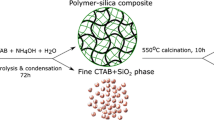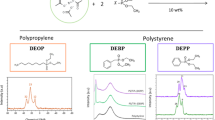Abstract
A new technique is described for preparing poly(propylene)-silica nanocomposites with the use of crazing of polymers in reactive liquid media that exhibit an adsorption capacity with respect to the polymer and contain functional groups able to enter into different chemical reactions, in particular, hydrolytic condensation. The advantage of this technique over conventional mixing is that the components can be mutually dispersed at the nanolevel without using additional modifying additives. The hydrolytic condensation of tetraethoxysilane and hyperbranched poly(ethoxysiloxane) in the presence of acid or base catalysts with the formation of a silica gel in a crazed polymer matrix is investigated. It is established that the morphology of the prepared composites is determined by the structure of the crazed polymer matrix, the nature of the precursor, and the hydrolytic polycondensation conditions. Composites are prepared in which the silica phase is located either inside the poly(propylene) matrix (in the form of a continuous phase or discrete particles) or on the surface of the polymer. Porous silicon plates are produced through heat treatment of the poly(propylene)-silicate nanocomposites at a temperature of 700°C.
Similar content being viewed by others
References
E. Kontou and M. Niaounakis, Polymer 47(4), 1267 (2006).
D. N. Bikiaris, A. Vassiliou, E. Pavlidou, and G. P. Karayannidis, Eur. Polym. J. 41(9), 1965 (2005).
M. M. Ray and M. Okamoto, Prog. Polym. Sci. 28(11), 1539 (2003).
E. M. Benetti, V. Causin, C. Marega, et al., Polymer 46(19), 8275 (2005).
M. J. Percy, J. I. Amalvy, D. P. Randall, and S. P. Armes, Langmuir 20(6), 2184 (2004).
S. Fujii, S. P. Armes, T. Araki, and H. Ade, J. Am. Chem. Soc. 127(48), 16 808 (2005).
J. S. Bergmann, H. Chen, E. P. Giannelis, et al., Chem. Commun. (Cambridge, UK), No. 21, 2179 (1999).
M. Alexandre, Ph. Dubois, T. Sun, et al., Polymer 43(8), 2123 (2002).
M. C. Gonçalves and G. S. Attard, Rev. Adv. Mater. Sci. 4(2), 147 (2003).
J. P. Hanrahan, M. P. Copley, K. J. Ziegler, et al., Langmuir 21(9), 4163 (2005).
I. M. Papisov, K. I. Bolyachevskaya, A. A. Litmanovich, et al., Eur. Polym. J. 35(11), 2087 (1999).
N. F. Bakeev and A. L. Volynskii, Solvent Crazing of Polymers (Elsevier, Amsterdam, 1995).
A. L. Volynskii, O. V. Arzhakova, L. M. Yarysheva, and N. F. Bakeev, Vysokomol. Soedin., Ser. B 42(3), 549 (2000) [Polym. Sci., Ser. B 42 (3–4), 70 (2000)].
A. L. Volynskii, E. S. Trofimchuk, N. I. Nikonorova, and N. F. Bakeev, Zh. Obshch. Khim. 72(4), 575 (2002) [Russ. J. Gen. Chem. 72 (4), 536 (2002)].
V. V. Kazakova, V. D. Myakushev, T. V. Strelkova, and A. M. Muzafarov, Vysokomol. Soedin., Ser. A 41(3), 423 (1999) [Polym. Sci., Ser. A 41 (3), 283 (1999)].
V. V. Kazakova, E. A. Rebrov, V. B. Myakushev, et al., ACS Symp. Ser. 729 (Chap. 34), 503 (2000).
E. S. Trofimchuk, N. I. Nikonorova, E. A. Nesterova, et al., Vysokomol. Soedin., Ser. A 49(10), 1801 (2007) [Polym. Sci., Ser. A 49 (10), 1107 (2007)].
R. Iler, Chemistry of Silica (Wiley, New York, 1979; Mir, Moscow, 1982), Vol. 2, pp. 706–708.
I. A. Karpov, E. N. Samarov, V. M. Masalov, et al., Fiz. Tverd. Tela (St Petersburg) 47(2), 334 (2005) [Phys. Solid State 47 (2), 347 (2005)].
K. A. Andrianov, Organosilicon Compounds (Goskhimizdat, Moscow, 1955), pp. 161–169 [in Russian].
W. M. Jones and D. B. Fischbach, J. Non-Cryst. Solids 101(1), 123 (1988).
A Chemist’s Handbook (Khimiya, Moscow, 1964), Vol. 3, pp. 337, 344 [in Russian].
A. L. Volynskii, L. I. Lopatina, and N. F. Bakeev, Vysokomol. Soedin., Ser. A 29(2), 398 (1986).
A. L. Volynskii, N. F. Bakeev, N. I. Nikonorova, et al., RF Patent No. 145418/04 (049593) (2006).
Author information
Authors and Affiliations
Corresponding author
Additional information
Original Russian Text © E.S. Trofimchuk, N.I. Nikonorova, E.V. Semenova, E.A. Nesterova, A.M. Muzafarov, I.B. Meshkov, V.V. Kazakova, A.L. Volynskii, N.F. Bakeev, 2008, published in Rossiiskie nanotekhnologii, 2008, Vol. 3, Nos. 3–4.
Rights and permissions
About this article
Cite this article
Trofimchuk, E.S., Nikonorova, N.I., Semenova, E.V. et al. Specific features of the formation of the silicon dioxide phase in porous poly(propylene) prepared through the crazing mechanism. Nanotechnol Russia 3, 201–208 (2008). https://doi.org/10.1134/S1995078008030063
Received:
Accepted:
Published:
Issue Date:
DOI: https://doi.org/10.1134/S1995078008030063




